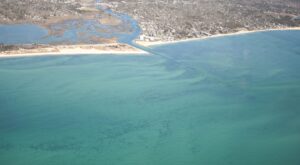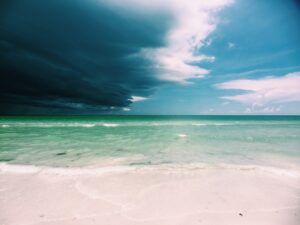The great flush: Scientists weigh in

Welcome back to our wastewater series, The Great Flush. In this episode, host and producer Gilda Geist interviews three Woods Hole scientists to get to the bottom of the nitrogen problem caused by wastewater on Cape Cod.
Listen on The Upper Cape Catch.
When boreal forests burn in the Far North of the U.S. and Canada, the whole world feels the impact. From communities evacuating from the blazes, to smoke clogging the air thousands of miles to the south, to the release of carbon emissions that accelerate climate change, boreal forest fires are a global issue.
Research from Woodwell Climate has recently expanded our understanding of the scope of impact that boreal fires have. A new paper, led by Research Associate Stefano Potter, quantified emissions associated with fires across most of boreal North America, shedding light on the dynamics of boreal fires and climate change. These four graphics explain:
1. Boreal fires threaten an important carbon sink.
Using a new higher-resolution dataset, generated as part of NASA’s Arctic-Boreal Vulnerability Experiment (ABoVE), Potter and his co-authors created a map of burned area across the boreal region. The researchers combined satellite imagery with observations from the largest database of boreal field studies, which allowed them to calculate emissions from both vegetation burned aboveground, and organic matter in the soils that burned belowground.
The results show that the overwhelming majority of carbon emissions from boreal fires—over 80% of total emissions in most places—comes from soils rather than trees. Despite the dramatic imagery of burning forests, most of the real damage is happening below the ground.
2. The true impact of boreal emissions is currently underestimated.
That finding on its own was not surprising to researchers, as the majority of carbon in boreal forests is stored below the ground. However, the fact that the overwhelming contribution of belowground carbon to fire emissions is being left out of existing global fire and climate models, means we’re drastically underestimating carbon emissions from Arctic and Boreal environments.
“A large reason for that is because the [existing] models are not detecting the belowground carbon combustion, which we are modeling directly,” says Potter.
Potter and the team working on the paper were able to accurately model belowground carbon loss because of their machine learning approach and the abundance of available field measurements in their dataset.
Accurately representing these numbers in global fire models is critical, because these models are used to plot climate trajectories and inform carbon budgets, which tell us how much we need to cut emissions to stay below temperature thresholds like 1.5 or 2 degrees C.
3. Boreal fires are becoming more intense.
It is becoming more urgent to get an accurate understanding of boreal emissions, because boreal fires are becoming larger, more frequent and more intense. Burned area has increased as fire seasons stretch longer, return intervals between fires shorten, and single ignitions can result in massive blazes that burn further and deeper and cause greater carbon loss.
In 2023, for example, while the number of ignitions has been lower than most years since the 1990s, burned area as of August has far surpassed any year in the past three decades.
4.Fire suppression can be a cost effective protection against carbon loss.
Ultimately, preventing carbon loss from boreal forest fires will require bringing down emissions from other sources and curbing warming to get fires back within historical levels. But preventing boreal forests from burning in the short term can offer a climate solution that could buy time to reduce other emissions.
A collaborative study between Woodwell Climate and the Union of Concerned Scientists, published in Science Advances, modeled the cost effectiveness of deploying fire suppression in boreal North America and found that actively combatting boreal fires could cost as little as 13 dollars per ton of CO2 emissions avoided—a cost on par with other carbon mitigation solutions like onshore wind or utility-scale solar. Informed by this data, the U.S. Fish and Wildlife Service has decided to start combating fires in Yukon Flats National Wildlife Refuge, not only when they present a threat to human health, but also with the intent of preventing significant carbon losses. Yukon Flats is underlain by large swaths of carbon-rich permafrost soils, at risk of thawing and combusting in deep-burning fires.
Deepening our understanding of the complex boreal system with further research will help inform additional strategies for bringing emissions under control, preventing devastating fires that threaten human health both regionally, and across the globe.
Shaky ground
A company called Indigo is paying farmers to trap carbon in their soils. Some researchers say the climate benefits are dubious
Lance Unger has been doing things a little differently lately on his farm near the Wabash River in southwestern Indiana. After last fall’s harvest, rather than leaving his fields fallow, he sowed some of them with cover crops of oats and sorghum that grew until the winter cold killed them off. And before planting corn and soybeans this spring, Unger drove a machine to shove aside yellowing stalks—last season’s “trash,” as he calls it—rather than tilling the soil and plowing the stalks under.
Google.org awards $5 million for real-time AI permafrost thaw analysis
Woodwell Climate Research Center (formerly the Woods Hole Research Center) in Falmouth, Massachusetts, has announced a $5 million grant from Google.org for the development of open-access satellite data and AI resources to track Arctic permafrost thaw in near real time.
Timely analysis of permafrost thaw, a critical resource to scientists, decision makers, and community members helping to inform climate change mitigation and adaptation strategies, has remained out of reach due to the limitations of current remote sensing and satellite imagery analysis techniques.
Read more on Philanthropy News Digest.
Summit County, Utah is preparing for a changing climate.
The high-elevation county boasts a strong winter sports economy, vast swaths of national forest and agricultural land, and a population of 43,000 people that stand to be affected by climate-driven changes. The risks to the county’s health and economy from climate change were outlined in a recent report by Woodwell Climate, and shared with the community through the first in a series of climate change and public health panels.
The risk assessment was completed as a part of the Center’s Just Access initiative to provide free climate risk insights to municipalities across the globe, in order to equip them for the changes ahead. Working with members of Summit County’s Sustainability Department, as well as members of the community at large, the Woodwell team targeted three major climate risk variables for analysis— drought, water scarcity, and wildfire.
According to Emily Quinton, Sustainability Program Manager for Summit County, these risks are ones the county is already concerned about, based on existing conditions, but wanted to know what that would mean for them in coming decades.
“We have some good baseline knowledge about the risks we are facing already,” Quinton said. “What was different and new that the Woodwell assessment could offer was those much longer-term future projections.”
In Summit County, the Sustainability Department is a subset of the Public Health Department, which encouraged the risk assessment to delve into the ways in which climate risks affect the health of county residents. Changes in water availability were a particular concern for the department.
The report found that the northern and easternmost portions of the county are most likely to be affected by drought. Summit County is already experiencing severe drought conditions 40% of the year; that number is expected to increase to 50% by midcentury.
Water scarcity will also increase. Driven by both increasing demand from the population and decreasing availability, water scarcity in most communities within Summit County is expected to be at 189% by 2030— meaning demand will be nearly twice that of available supply.
“With the drought and water scarcity topics,” said Quinton, “making the connection between how a decrease in water quantity will place risk on water quality was important. Monitoring water quality is a really crucial responsibility of the Public Health Department.”
Woodwell Research Assistant, Darcy Glenn, who worked previously in Summit County’s Sustainability Department and helped facilitate the production of the report says, “If you don’t have any water in your wells, water quality goes down because you don’t have enough to dilute any contaminant that might be a problem.”
Summit County currently grapples with wildfire threat as well. Wildfire danger days— in which temperature and moisture conditions make fires more likely to burn out of control— will become a more common occurrence, leading to fires that cause more evacuations, damage, and air quality concerns. The majority of the county will add eight or more wildfire danger days to their year by the end of the century.
Climate Change and Public Health
Public health can be a less polarizing context in which to discuss climate risks publicly. Despite the political nature surrounding climate change in some regions, Glenn notes public health can serve as a lens most people relate to and take seriously.
“It can be hit or miss on climate change, but if your kid has asthma, you want to know about your air quality. Changes in the environment, whether people acknowledge climate change or not, align with things they’ve seen,” says Glenn. “So we’re trying to approach the topic in a way that’s accessible and start a conversation that’s welcoming to the whole community.”
After the completion of the assessment, Woodwell Risk team members presented the information to the Summit County Board of Health, then opened up communications with the public. In May, the county’s Health Department hosted the first of three planned events in a speaker series, focused on sharing the results of the report to help county residents better understand the extent of risk where they live. Glenn spoke alongside local climate experts and took questions from attendees.
The next two events in the series will discuss the physical and mental health impacts of climate change, as well as some potential adaptation solutions. According to Quinton, these events will aid the county in developing plans for resilience that address the top concerns of the public.
“Climate preparedness can’t happen without an understanding of what the potential risks are. The Climate Risk Assessment and the public events feel like important steps to more directly integrate climate change into the preparedness work Summit County is already doing,” says Quinton.
Charts: The water at the tip of Florida is reaching hot tub-level highs

Come on in, the water’s fine — if you like hot tubs. The water temperature on the tip of Florida hit 100 degrees two days in a row this week. Experts say that could potentially be the hottest seawater ever measured, although there are some issues with the reading.
The buoy collecting data on water temperature in shallow Manatee Bay, which is off the Everglades and blocked off from the ocean by North Key Largo, recorded a temperature of 100.2 degrees Sunday night and 101.1 degrees Monday evening.
Continue reading on The Boston Globe.



